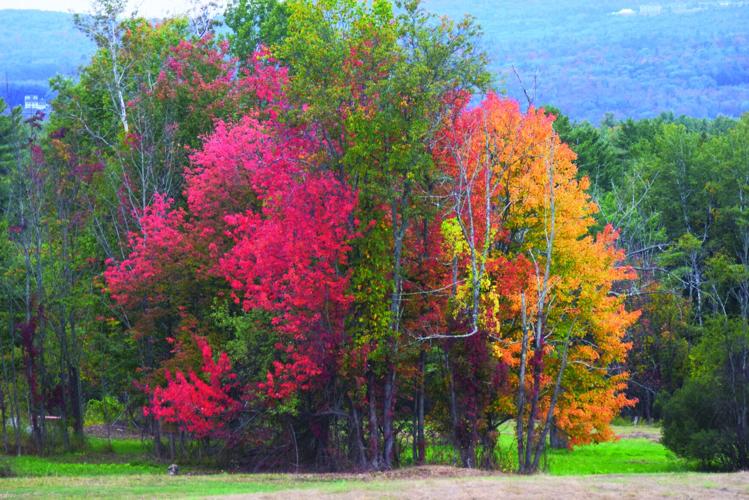Peak foliage is right around the corner, and in some places in the Lakes Region, those bright colors are popping early.
Climate experts said it can be tough to narrow down when foliage peaks, especially due to drought conditions, but some areas are already in the midst of a color explosion, while others should be coming in a week or so.
“Typically, what we see with a drought is that once the leaves start turning, they can fall quickly,” said Mary Stampone, the New Hampshire state climatologist and an associate professor of geography at the University of New Hampshire. “The drought is usually not very good for spectacular foliage, but I am seeing the colors out there, and it is lovely.”
Stampone said the unseasonably warm weather, with plenty of sun, is perfect for walking in the woods to see the oranges, yellows and reds.
“We need rain, but the silver lining is the weather is phenomenal for taking in all the fall activities,” Stampone said.
Stampone explained the Lakes and White Mountains regions are experiencing more intense drought conditions than other parts of the Granite State. She said rain last week helped, but the area is still in severe to extreme drought conditions.
“What we see with that kind of rain is that the precipitation deficit is so deep that we need like, five more of those to happen over the course of October and November,” she said.
Crystal Stiles, the acting regional drought coordinator for the National Oceanic and Atmospheric Administration, said early leaf drop can happen with a drought. She said trees are stressed by drought, and try to retain water. By dropping leaves, tress will have a better chance at preserving water in their trunks.
“One thing I have heard is that trees that are stressed are turning brown, so we may not be seeing quite as many bright, vibrant colors,” Stiles said. “We are experiencing some of the worst drought conditions in the Northeast.”
Stiles agreed with Stampone the few days of rain last week were helpful, but there isn’t much more precipitation in the forecast. Trees will continue to conserve water in their trunks, and — since leaves take up water — they will lose them faster.
“To summarize, I am hearing peak could possibly be earlier than normal, because of the trees being stressed and the early leaf drop,” Stiles said.
A recent report from UNH echoes what Stiles and Stampone said, indicating the leaves could just be changing a bit earlier than expected.
According to Steve Roberge, a UNH Extension forestry specialist and professor of natural resources, the drought is widespread, but there are still leaves turning. He said as long as there is a green canopy, leaf peepers should be able to catch bright foliage colors.
“The dry conditions are causing the leaves to show off their colors earlier, and in some cases may not be as bright, but I’ve driven all around the state in the last few weeks and there is still a lot of foliage boasting those expected hues and should be more well into October,” Roberge said in the UNH report.
Roberge said foliage colors are all weather-dependent, and sufficient rainfall is needed during growing season. Also needed are warm, sunny days, paired with clear, cool nights as summer turns to fall.
“Even with all the drought, you still see color because it is already in the leaves from the rainy weather we had this spring,” Roberge said in the report. “The color’s reveal is controlled by the length of the days and nights as we head into fall. What has been great so far are these lovely 45 degree nights that help to bring out the first reds and deep purple colors.”
The report stated when temperatures during the day are still in the 70s and even 80s, and drop to the 40s at night, tree cells break down sugars, and production of green chlorophyll slows down. This causes the carotenoids and anthocyanins to come out, showing off the fall colors we all know and love.
Roberge said by taking a drive or a walk, or just looking around, it will be easy to find red maples and yellow birches showing bright colors.
“People always ask me when peak leaf peeping season is going to be and I always say whenever you have the time to get out and enjoy it,” Roberge said in the report.
Lakes Region Tourism Association Executive Director Amy Landers said there was concern about whether the season would be early, but so far things are on track. She acknowledged Route 104 seems to be peaking now, but moving down toward the rest of the Lakes Region, the leaves still have a little way to go.
Landers said, overall, people she spoke with are positive going into fall foliage season.
“At our last board meeting, people were very positive about our pre-bookings and pre-reservations coming in,” Landers said. “Weddings have been strong, and we just all have our fingers crossed that foliage will stay on track and be peak right after Columbus Day, like usual.”
The state Division of Travel and Tourism Development's fall foliage map currently has the Lakes Region listed for peak foliage around Wednesday, Oct. 8. To see the map, log on to visitnh.gov/plan-your-trip/fall/foliage-tracker.



















(0) comments
Welcome to the discussion.
Log In
Keep it Clean. Please avoid obscene, vulgar, lewd, racist or sexually-oriented language.
PLEASE TURN OFF YOUR CAPS LOCK.
Don't Threaten. Threats of harming another person will not be tolerated.
Be Truthful. Don't knowingly lie about anyone or anything.
Be Nice. No racism, sexism or any sort of -ism that is degrading to another person.
Be Proactive. Use the 'Report' link on each comment to let us know of abusive posts.
Share with Us. We'd love to hear eyewitness accounts, the history behind an article.